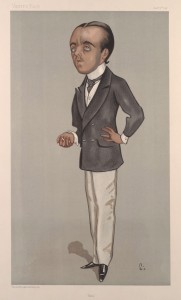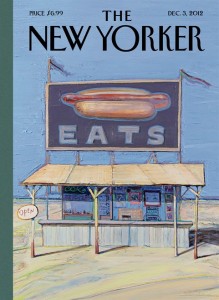HG has been looking at the March 21 cover of The New Yorker for some days. Each look brings a smile. The cover, “Spring Forward,” features a gentleman with a green mustache; pink, white and green blossoms; a small black and white dog. The artist is Maira Kalman, an HG favorite. A joy looking at the cover and walking in HG/BSK’s gardens alive with daffodils, hyacinths and golden forsythia. Spring is alive and well in New Mexico. Maira Kalman is a delightful, multi talented artist, illustrator and designer. Born in Tel Aviv in 1949. Came to USA when she was four. Lives in Brooklyn (of course). She was married, until his untimely death (at age 50) to Tibor Kalman, founder of the very successful cutting edge design company, M & Company. Maira Kalman shares HG’s love for dogs and Pete, a cute little guy, was her companion for many years. Maira is prolific. More than a score of books, a number of New Yorker covers and illustrations for other magazines. Wrote a blog for The New York Times, “Principles of Uncertainty” which was later published as a book. She’s done a number of very funny books of illustrations featuring, Max, The Poet Dog. These including “Max in Hollywood, Baby” and “Ooh, La, La , Max Is In Love” (in Paris). HG/BSK’s gifted daughter, Lesley R., introduced HG/BSK to Maira with a Christmas gift of Beloved Dog, a charming book inspired by Pete and dedicated to Maira’s children. Buy it if you enjoy dogs, quirky and witty art, life. Published by Penguin Bookis
Maira Kalman
March 27th, 2016 § 2 comments § permalink
Jonathan Schell R.I.P.
July 23rd, 2014 § 2 comments § permalink
Jonathan Schell, age 70, a brilliant journalist/historian died at his Brooklyn home a few weeks ago. Schell’s work (most of which appeared in The New Yorker and The Nation) aroused emotions in HG, namely anger, fear and sadness. That’s because he wrote about the worst ailments of our time: Global warming, nuclear weaponry, the Vietnam and Iraq wars, the near destruction of the American democracy during the regime of Richard Nixon. Three of his books are essential reading: The Village of Ben Suc (written when Schell was only 24, it sums up the Vietnam madness through one horrifying incident ); The Fate of the Earth, a frightening analysis of the possible end of our planet; The Time of Illusion, the history of the Nixon presidency and its reliance on lies, fear and downright criminality. No, Schell provided little comfort. But, dedicated truth tellers rarely do.
The Incomparable Max
August 16th, 2013 § 0 comments § permalink
Does anyone read the works of Max Beerbohm anymore? Or look (with amusement) at his brilliant caricatures? HG has been a lifelong fan of this adroit and elegant personality, an English dandy of the Edwardian era. Dead for some 57 years, his prose (described as “lapidary” by one critic) still sparkles. As rain lashed Prince Edward Island, HG found solace sipping locally distilled pastis from the Myriad View Distillery and reading Mainly On the Air, a collection of Sir Max’s BBC radio broadcasts and essays. What is magical about this collection is that Beerbohm writes about forgotten writers, obscure playwrights, antique music hall songs and performers and makes HG smile in remembrance of a life HG never lived. There are wonderful archaic phrases and English words that have withered from disuse. Max makes them live again. George Bernard Shaw called him “The Incomparable Max.” Very apt. Beerbohm, during his lifetime, published many books of prose, fiction and dramatic criticism as well as volumes of caricatures. A nice introduction to his work and character is the charming book, Portrait of Max, by S.N. Behrman, a collection of articles Behrman did for The New Yorker Magazine.
Mitchell, McNulty (and SJ)
February 14th, 2013 § 0 comments § permalink
In the most recent New Yorker Magazine, there is a beautiful, heartbreaking piece by the late Joseph Mitchell (1908-1996) entitled: “Street Life: Becoming Part of the City.” In a brief introduction, the New Yorker states: “What follows here is the initial chapter of a planned memoir that Mitchell started in the late sixties and early seventies but, as with other writings after 1964, never completed.” From 1964 to 1996, Mitchell went to his New Yorker office every day but never published a word. Street Life proves once more that nobody wrote about New York City, its places and people, with Mitchell’s eloquence, grace and sensitivity. It is heartbreaking for lovers of the New York City and journalism (a type of journalism that can only be described with the adjectives: literary and poetic) that Mitchell did not publish for 32 years. If you haven’t read Mitchell, check out Amazon for his books (collections of his New Yorker articles). You will be rewarded. Mitchell wrote wonderfully about food — namely seafood (though he did the definitive article on a gluttonous old New York event called a “Beefsteak”). Mitchell loved the Fulton Fish Market, its Sloppy Louie’s Restaurant and its unique raffishness. One of his composite characters, Old Mr. Flood. describes himself as a seafoodetarian. While Mitchell was the Poet Laureate of the Fulton Fish Market, another New Yorker writer, the lamentably short lived John McNulty (1896-1956), was the Poet Laureate of Third Avenue (the Third Avenue which had an El rumbling overhead; the Avenue which was lined with Irish saloons and Jewish pawn shops). Nobody ever wrote better about ordinary New Yorkers, horseplayers, bar room beer drinkers, unsung laborers, office workers, news dealers, etc. James Thurber, his New Yorker colleague, said about him: “Nothing, however commonplace, that he touched remained commonplace, but was magnified and enhanced by his intense and endless fascination.” (Permit justified parental pride. The same words could be applied to SJ and the series of “Sad Chairs” photos and poetic prose SJ posts almost daily on his Sad Chairs Blog. Better than anyone, SJ evokes the bittersweet qualities of urban life. Log into http://sadchairs.tumblr.com/ to experience a very individual view of the city.)
The English Language
January 8th, 2013 § 0 comments § permalink
Yes, HG becomes concerned about the beauty of the English language at a time when “fun” has become an adjective rather than a noun; a time when the adverb has been banished and “You’re welcome” has been replaced by “No problem.” However. There is still England and The Economist, a magazine that calls itself a newspaper. Every issue contains memorable English prose. Over the last months there was a review of a book: “God’s Doodle: The Life and Times of the Penis.” The review (as does the book, says the reviewer) proves that one can write about this significant appendage without prurience, pornography, puritanical fastidiousness or forced hearty jollity. And, there’s an obituary of Brian Cobby, “Britain’s Male Speaking Clock.” From 1985 to 2007, it was Cobby’s voice, on the other end of a telephone line, that gave Britons the correct time — accurate to within five milliseconds. This is an obituary that muses amusingly about Time and its various manifestations while, at the same time, painting a portrait of a delightful, typically English, eccentric. And any fan of HBO’s wonderful series Treme will love the article “Home-Grown and Spirit-Raised: An Exuberant New Orleans Ritual Commemorates the Friendship of Escaped Slaves and Native American.” in the Dec / Jan double issue. HG is no Economist press agent and HG is only faintly an obsessed Anglophile, so HG recognizes that good English prose can be found in some American publications. Adam Gopnik in the New Yorker always gives HG pleasure.
New Yorker Food Issue
December 6th, 2012 § 0 comments § permalink
The annual New Yorker Food Issue is out and has some good reading for the food obsessed. Calvin Trillin has a piece on the cuisine of Oaxaca, Mexico. Makes you want to grab the next plane to that city even if you have no desire to eat caterpillars and worms, two local specialties. Mimi Sheraton does a riff on sausages including a description of a goose and goose liver sausage she ate in Hamburg some years ago. Very appetite provoking. HG has always felt Mimi Sheraton was the best of the New York Times restaurant reviewers. She reigned between 1975-1983. She was fair, balanced and funny. She concentrated on a restaurant’s food rather than going on and on about the hipness (or lack) of the restaurant’s clientele. Sheraton has written some good books. From My Mother’s Kitchen is a delightful memoir and very evocative of a vanished New York. As a plus, it has some good, down to earth recipes. HG liked Craig Claiborne, the original Times reviewer. However, like many a New York transplant from the South, Claiborne never met a Jewish delicatessen or Chinese restaurant he didn’t love. The man had great judgement in matters concerning French cuisine. But, when it came to pastrami or shrimp in black bean sauce — Fuhgeddabout it!!
The Best Food Book In Creation
May 30th, 2012 § 0 comments § permalink
Secret Ingredients: The New Yorker Book of Food and Drink, is an anthology from the pages of New Yorker Magazine and edited by David Remnick. In HG’s opinion, it is the best food book ever created. There are articles that will make you hungry (A.J. Liebling on the Paris restaurants of his youth; Joseph Mitchell on the old New York steak dinner or “beefsteak”; Joseph Wechsberg on French chef Fernand Point). Some will make you think (Adam Gopnik on French cuisine). Some will make you laugh (Calvin Trillin, Ogden Nash, Steve Martin, Dorothy Parker, Woody Allen and S.J. Perelman). Some may make you weep (Alice McDermott’s bittersweet fiction, “Enough,” on the varieties of appetite and desire). And, there’s one that may make you queasy. HG refers to “A Rat In My Soup” by Peter Hessler. The intrepid author visits Luogang, China, where two restaurants, The Highest Ranking Wild Flavor Restaurant and the New Eight Sceneries Wild Flavor Food City specialize in rat (yes, some tasty cat and snake dishes are also available). Hessler dines on Simmered Mountain Rat With Black Beans and Spicy and Salty Mountain Rat. He discovers, no surprise, that rat really isn’t very tasty. Anyway, “Secret Ingredients” is savory fare, indeed






